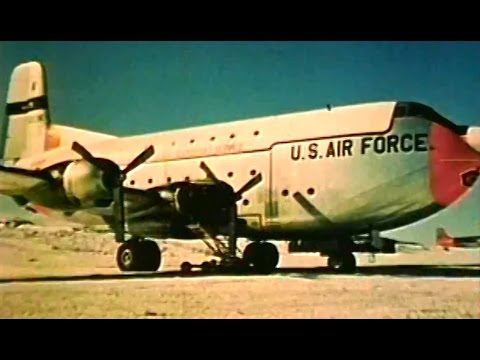MATS Deepfreeze Airlift 1961 US Air Force Antarctica Byrd Station Supply
more at:
“DOCUMENTS MATS DEEPFREEZE AIRLIFT CONDUCTED IN 1960 TO SUPPORT THE ANTARCTIC SCIENTIFIC EXPEDITION. SHOWS HOW CREWS AIRLIFT EQUIPMENT AND SUPPLIES TO MCMURDO SOUND AND AIRDROP 91,000 TONS OF FUEL OIL AT BYRD STATION AND SOUTH POLE STATION.”
Public domain film from the US National Archives, slightly cropped to remove uneven edges, with the aspect ratio corrected, and mild video noise reduction applied.
The soundtrack was also processed with volume normalization, noise reduction, clipping reduction, and/or equalization (the resulting sound, though not perfect, is far less noisy than the original).
Operation Deep Freeze (OpDFrz or ODF) is the codename for a series of United States missions to Antarctica, beginning with “Operation Deep Freeze I” in 1955–56, followed by “Operation Deep Freeze II”, “Operation Deep Freeze III”, and so on. Given the continuing and constant US presence in Antarctica since that date, “Operation Deep Freeze” has come to be used as a general term for US operations in that continent, and in particular for the regular missions to resupply US Antarctic bases, coordinated by the United States military…
The U.S. Navy already had a record of earlier exploration in Antarctica. As early as 1839, Captain Charles Wilkes led the first U.S. Naval expedition into Antarctic waters. In 1929, Admiral Richard E. Byrd established a naval base at Little America I, led an expedition to explore further inland, and conducted the first flight over the South Pole. From 1934–35, the second Byrd Expedition explored much further inland and also “wintered over”. The third Byrd Expedition, in 1940, charted the Ross Sea.
After World War II, from 1946–47, Byrd was instrumental in the Navy’s Operation Highjump that charted most of the Antarctic coastline. In 1948, Commander Finn Ronne led an expedition that photographed over 450,000 square miles (1.1 million km²) by air. Then, in 1954–55, the icebreaker USS Atka (AGB-3) made a scouting expedition for future landing sites and bays.
The impetus behind Operation Deep Freeze I was the International Geophysical Year 1957–58. IGY, as it was known, was a collaboration effort between forty nations to carry out earth science studies from the North Pole to the South Pole and at points in between. The United States, along with New Zealand, the United Kingdom, France, Japan, Norway, Chile, Argentina, and the U.S.S.R., agreed to go to the South Pole—the least explored area on Earth…
In 1955 Task Force 43 was formed to carry out this work. Operation Deep Freeze I prepared a permanent research station and paved the way for more exhaustive research in later Deep Freeze operations. The expedition transpired over the Antarctic summer of November 1955 to April 1956…
On 31 October 1956, US Navy Rear Admiral George J. Dufek [2] and others successfully landed a R4D Skytrain (Douglas DC-3) aircraft at the South Pole, as part of the expeditions mounted for the IGY. This was the first aircraft to land at the South Pole and the first time Americans had set foot on the South Pole. This marked the beginning of the establishment of the first permanent base, by airlift, at the South Pole (today known as the Amundsen-Scott South Pole Station) to support the International Geophysical Year.
The Operation Deep Freeze activities were succeeded by “Operation Deep Freeze II”, and so on, continuing a constant US presence in Antarctica since that date.
Subsequent developments
In early 1996, the United States National Guard announced that the 109th Airlift Wing at Schenectady County Airport in Scotia, New York was slated to assume that entire mission from the United States Navy in 1999. The Navy’s Antarctic Development Squadron Six had been flying the missions. The 109th, which operated ski-equipped LC-130s, had been flying some National Science Foundation support missions to Antarctica since 1988. It had flown scientific and military missions to Greenland and the Arctic since 1975. The Antarctic operation would be fully funded by the National Science Foundation…
The Douglas C-124 Globemaster II, nicknamed “Old Shaky”, was a heavy-lift cargo aircraft built by the Douglas Aircraft Company in Long Beach, California.
The C-124 was the primary heavy-lift transport for United States Air Force Military Air Transport Service (MATS) during the 1950s and early 1960s, until the Lockheed C-141 Starlifter entered service. It served in MATS-gained, later Military Airlift Command (MAC)-gained, units of the Air Force Reserve and Air National Guard until 1974…

